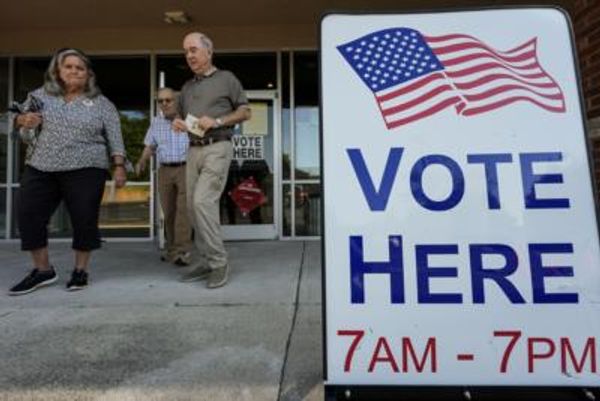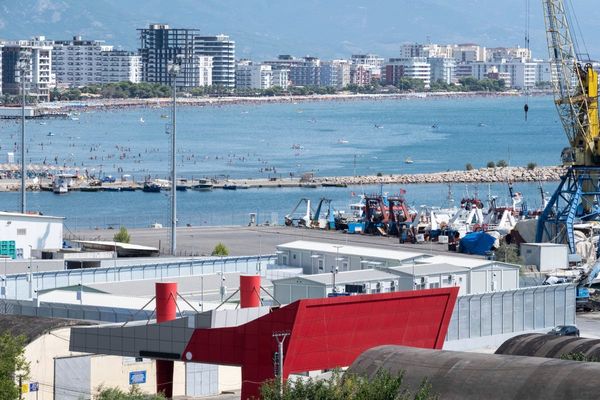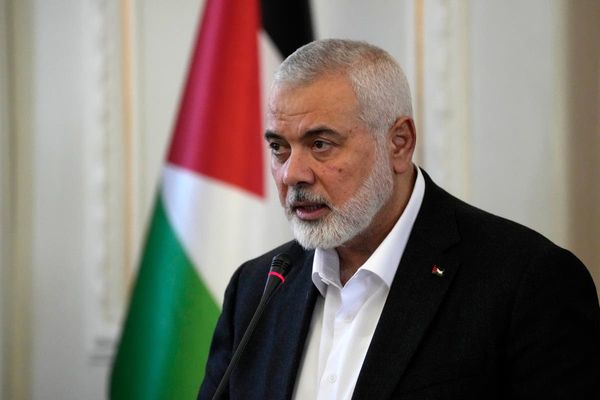
Aboriginal and Torres Strait Islander readers please note that this article contains images and mention of deceased persons. It also contains depictions of violence and racism.
The image is repulsive. Consider the faded contours of the Kimberley pastoral station stretching into the vast distance to the left; how it’s partially obscured by the tin edifice that was the Wyndham prison around 1901, and how both speak to the unchecked avarice and prejudice that situated the group of boys and men in the dusty dirt at the photo’s centre.
Now focus on the two most striking parts of the frame: the handcuffed and chained existence of the boys and men, who are shackled together by neck chains weighing close to 2.5kg each. And behind them, pipe in hand, their keeper, a white man sporting a handlebar moustache and a hint of triumphalism.
In the way of so many signal moments that capture the nation’s bloodstained history, the frame is a portal into a world of injustice, where for more than a century until 1958 the systemic (though illegal) use of neck chains on Indigenous peoples persisted throughout Western Australia. This was so notwithstanding its parallels with the transatlantic slave trade, as well as the findings of the Roth royal commission of 1905, which found the “brutal and outrageous” practice was commonly justified by reference to spurious and unscrupulous allegations of cattle theft.
Spurious, because confessions of cattle theft were often extracted from Indigenous prisoners on threat of murder by gunpoint. And unscrupulous, because such claims scarcely concealed the usual, unvarnished purpose of the arrests, which was to expel Indigenous communities from their ancestral lands and, in some instances, press them into slavery.
Knowing the recommendations of the Roth royal commission were, for the most part, duly ignored, and knowing history dared to repeat itself with the royal commission into black deaths in custody some 82 years later in 1987, a thorny question arises: what do you see in the photo? Or perhaps more to the point, what do you want to see?
Something from the closed, distant past, or something with a legacy or parallel that writes the gap between the promise of our egalitarian ideas and the realities of today and tomorrow?
The question matters because among the most obnoxious yet potent lies peddled by the No campaign is the dangerously loose claim that a Voice to Parliament would run contrary to basal notions of equality and egalitarianism. In May, for instance, Opposition Leader Peter Dutton used a speech in Parliament to speak of a crisis in identity and national cohesion, warning the Voice would cast an “Orwellian” shadow over the nation where “all Australians are equal but some Australians are more equal than others”.
He worried the proposal would “re-racialise our nation” and “permanently divide us by race”. And he echoed (without attributing) Martin Luther King Jr’s “I have a dream” speech, telling the chamber the “great progress of the 20th century’s civil rights movement was the push to eradicate difference — to judge each other on the content of our character, not the colour of our skin”.
In recent days, 2GB host Ben Fordham has played on this sentiment, accusing Labor of trying to create “an exclusive group”, while Louise Clegg, a strong opponent of the Voice, has urged the country to heed Dutton’s warnings, pointing to the dangers of “affording a small group of people an elevated right above all others to a say on everything”.
And so on it goes.
To the minds of anyone unpersuaded by the merits of the Voice, the tenor or “vibe” of such arguments is at least superficially compelling.
On one level, it comfortingly invites Australians to reject the notion that ours is a nation in which Indigenous peoples confront anything approaching discrimination or structural bias in their day-to-day lives, let alone racism. Once that’s accepted, the Voice descends into something that’s liable to breed resentment and accusations of “reverse discrimination”, where instead of cautious reform designed to mitigate chronic Indigenous disadvantage, it’s recast as a cudgel that will inevitably hurt ordinary, non-Indigenous Australians.
Hence Clegg’s claim the Voice will have a “say on everything”, as opposed to at best a limited “power of influence” over laws that affect them in some material or distinct way, and the common but false refrain the Voice will violate principles of anti-discrimination.
But even to those not sold on the beguiling idea that racial discrimination is a thing of the past, much less the unreality of “reverse discrimination”, it’s possible the argument still holds some force.
These people, it bears emphasising, wouldn’t necessarily consider themselves racist, and nor would they oppose diversity or Indigenous reconciliation. On the contrary, at least to their thinking, it merely strains faith to conceive the Voice as something which doesn’t philosophically run contrary to liberalism’s promise of equal rights for all.
And it’s therein the true genius of Dutton’s sophistry on the Voice lies. By mawkishly evoking a common civic creed and monopolising the universalism of basic human rights — but skilfully ignoring the discrete rights of Indigenous peoples under the UN Declaration on the Rights of Indigenous Peoples, which Australia has supported since 2009 — the No campaign has refashioned the Voice as something that promises to derail history’s bend towards justice.
Indeed, it’s a variation of what some have called liberalism’s “doom loop”, where cultural heterogeneity and true egalitarianism can be seen to pull against each other, as borne out by the curtailing of affirmative action in American colleges last month.
By contrast here, in the context of the Voice, it’s a subterfuge of the worst kind; a victory of theatre over substance, if you like, or a sideshow of deceit and unreality.
Scratch away at the rhetoric’s putative concern for egalitarianism, what lies beneath is an arid cultural nationalism that deliberately and dangerously pitches Indigenous peoples against the rest. Nowhere is this more vividly captured than in the corrosive words of former prime minister Tony Abbott, where he recently spoke of “two classes of Australians: the few, whose ancestry here could be traced back some 60,000 years; and the many, whose ancestry in this country dates only from 1788”.
It’s the sort of language that can quickly descend into something far uglier or reflexively contrarian, such as Senator Jacinta Nampijinpa Price’s claims this week that Victorians are “difficult” and devoid of “common sense”; former federal Labor MP and no campaigner Gary John’s suggestion that Indigenous people should be blood-tested for “all benefits and jobs”; John Howard’s claim today that the “luckiest thing” to have happened Australia was British colonisation, and Dutton’s sly and unsubstantiated claim in October, repeated in April, that child sexual abuse is “widespread” and “normalised” in Indigenous communities.
Stepping back, it’s a space which all too easily shades into illiberal populism, where outlandish lies and claims are weaponised against not just this fact or that minority but reality as a whole, leaving scant room for cool analysis.
One such lie, resurrected from the right’s graveyard of denial, is Dutton’s suggestion the long march of time has materially reduced First Nations disadvantage — never mind such claims find no reflection in the sobering statistics on Indigenous incarceration and low life expectancy. Nationally, almost one in three people behind bars is Indigenous, despite First Nations peoples comprising 3.8% of the population, while Indigenous men statistically reach only an age of 71, and Indigenous women 75, compared with 80 and 84 respectively for their non-Indigenous counterparts.
Distilled, such figures capture all the policy failures, historic wrongs, scientific triumphs and social sins of a nation in one fell swoop. They speak crude and truthful points that utterly dissolve the right’s false narratives about egalitarianism and fitful progress for Indigenous people.
Lost on those who veritably see the Voice as something which heralds inequality is the reality that equality, if it’s to be taken as a foundational idea, must take acknowledgement of inequality as its starting point. To do otherwise lands you in the realm of strained and artificial reasoning where it’s said — for instance — that everyone enjoys an equal right to the age pension (as the Federal Court recently decided), even if non-Indigenous Australians statistically enjoy it for significantly greater lengths of time due to longer lifespans unshaped by the consequences of more than two centuries of dispossession, marginalisation and disadvantage.
Or that everyone has an equal right to attend university, even if First Nations peoples are, in the choice words of Education Minister Jason Clare, more likely to “go to jail than go to university”. Or that everyone enjoys equal rights to live free from discrimination, even if these rights are more liable to recede and vanish in the lived experience of First Nations peoples.
Indeed, it’s the repeated failure of government to meaningfully partner with and consult Indigenous communities under the Closing the Gap agreement, the Productivity Commission points out today, which foredooms progress.
And so ultimately this, along with recognition of First Peoples as the “bearers of the first history of our continent”, is the strongest argument for a Voice. We’re technically all equal, yes, but some of us — most Australians — far more so than First Nations as a group. International law recognises that it’s this history of disadvantage, and the distinctive collective identity of Indigenous peoples, which justifies steps which ensure their views find reflection in mainstream laws that directly impinge upon them.
Yet instead of recognising this simple truth, the campaign has descended into a struggle for Australia’s identity, and one that pitches the country at a crossroads: one path promises the ugly nationalism and shattered trust fashioned by Dutton’s lies; the other embraces the generous, patriotic act of reconciliation the Voice extends to all Australians.
The path you prefer depends in large part on how you see or choose to see the photo of chained inequality above. Something that is of closed significance, or something that to this day reverberates in our prisons and the outcomes for Indigenous peoples across the nation.







